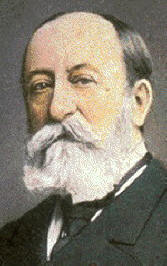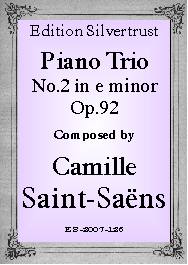Presents
Camille Saint-SaŽns
 |
Soundbite 1st Movement |
| Soundbite 2nd Movement | |
| Soundbite 3rd Movement | |
| Soundbite 4th Movement | |
| Soundbite 5th Movement |
Piano Trio No.2 in e minor, Op.92
 "I
am working quietly away at a trio which I hope will drive to despair
all those unlucky enough to hear it. I shall need the whole summer
to perpetrate this atrocity, one must have a little fun somehow."
So wrote Saint-SaŽns to a close friend in the spring of 1892 about
what has often been called the greatest French piano trio of the
19th century. The truth was that Saint-SaŽns worked long and hard on
this work, putting, as one critic noted, all of his accumulated
experience and wisdom into this it.
"I
am working quietly away at a trio which I hope will drive to despair
all those unlucky enough to hear it. I shall need the whole summer
to perpetrate this atrocity, one must have a little fun somehow."
So wrote Saint-SaŽns to a close friend in the spring of 1892 about
what has often been called the greatest French piano trio of the
19th century. The truth was that Saint-SaŽns worked long and hard on
this work, putting, as one critic noted, all of his accumulated
experience and wisdom into this it.
Although famous for his larger orchestral works and instrumental concertos, Camille Saint-SaŽns (1835-1921) devoted a great deal of time and effort to writing chamber music. Not only does he have two string quartets to his credit, but he also wrote three works for piano trio, a piano quintet, a serenade for piano, organ, violin and viola, a Septet for piano, trumpet, two violins, viola, cello and bass. Almost single-handedly, he attempted to make the case for chamber music at a time when most French thought of it as something German.
Piano Trio No.2 begins with an Allegro non troppo which is dark and ominous. It is a leisurely theme which takes its time as it builds tension toward an inevitable climax. When the climax is finally reached, powerful torrents of emotion are released. A second theme, a long time in coming, is more lyrical and optimistic. The chirpy theme of the second movement, Allegretto, begins like an inconsequential salon piece, but suddenly violent bursts of emotion interrupt it, and then a hectic, almost frantic melody, racing helter skelter, follows. When the main theme to the third and middle movement, Andante con moto, is briefly stated by the piano, it sounds almost inane, but as the strings enter, immediately the music exudes a strong perfume of romance, which over time reaches considerable emotional heights. The Grazioso poco allegretto which follows, though it starts with a dark chord, is light and graceful. The finale, Allegro, begins quietly and in a sinister vein. A canonic fugue is briefly begun and interrupted as the music skyrockets forward with tremendous ťlan.
Here is one of the great masterpieces of the piano trio literature. It is hard to understand why it is not a staple in the concert hall. Both professionals and amateurs will be glad to make its acquaintance.
Parts: $29.95